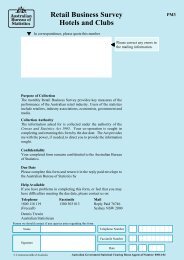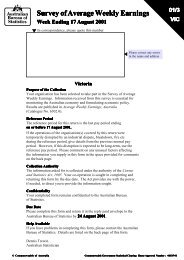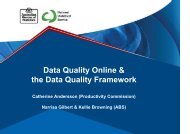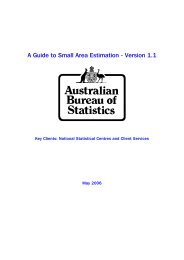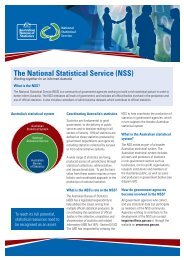Peter Harper Deputy Australian Statistician 14 March 2013
Peter Harper Deputy Australian Statistician 14 March 2013
Peter Harper Deputy Australian Statistician 14 March 2013
Create successful ePaper yourself
Turn your PDF publications into a flip-book with our unique Google optimized e-Paper software.
Origin of the ESA Initiative“The ABS should set out to identify, in a highly consultativeway, the key national datasets that are the essentialindicators of the state of the nation, regardless of whichorganisations produce them.”Allen Report (2004) – Recommendation 1: Areas ofduplication and underutilisation
Why Identify Essential Statistical Assets?"To guide Governments' investments in official statistics byprioritising and protecting those statistical assets that arecritically important for the nation."i. To identify where there are critical information gaps,so that these can be addressed;ii.iii.To ensure that information (statistics and datasets) are ofsufficient quality, and;To ensure the efficient use of Government resources byidentifying areas of duplication and underutilisation
Framework of Official StatisticsEssential StatisticalAssets for AustraliaOther StatisticsExistMeet qualitystandardsDon't yet meetquality standards(Investment priority)Self select to meet standardsAll other existing statisticsDon'tExistStatistical Gap(Investment priority)Statistical Gap
Essential Statistical Assets for Australia Framework
ESA Initiative – Project Phases• Phase 1 - Identification of the Essential Statistical Assets• Phase 2 - Assessing the Quality of existing Statistical Assets• Phase 3 – Identification of essential statistical infrastructure• Phase 4 - Discussing and determining the priorities forfuture investment
Phase 1 Consultation Process<strong>March</strong>-AprilMay -SeptemberSeptember -OctoberNovember
Consultation Summary• Positive support for the purpose of the initiative• Data custodians keen for their datasets recognised on the list• Identification of future data gaps neededSector Formal Informal* TotalGovernment – <strong>Australian</strong>Government17 9 26Government – state/territory 22 26 48Government – other 3 2 5NGO/industry/individual 17 1 18Total 59 38 97*Includes meeting summaries and responses from individuals within government departments. Some departments haveprovided more than one submission.
Key issues arising from feedback1. Impact for statistics not on the list2. Governance of the list in prioritising and protectinginvestment in statistics3. Relative Importance of each criterion4. Use of criteria in determining essentiality5. Need for future statistical requirements to be identified6. Alignment and collaboration with other initiatives7. Ambiguity over statistical labels
List specific feedback• 19 new statistics suggested• Strong support for the elevation of several just-out statistics:• Capital Expenditure• Building Approvals and other housing activity statistics• Job Vacancies• IT use and innovation by businesses• Literacy and Numeracy (students and adults)• Early Childhood Development• Feedback on disaggregations less prevalent• Indigenous and sub-state spatial disaggregations mostcommonly identified
Process for finalising the ESA for Australia ListDec 2012- ABS finalisation of proposed listJan <strong>2013</strong>- Follow-up Commonwealth Interdepartmental meetingFeb <strong>2013</strong>- Extraordinary ASAC meeting to endorse list<strong>14</strong> <strong>March</strong> <strong>2013</strong>- Release of 1395.0 – Essential Statistical Assetsfor Australia, <strong>2013</strong>
The <strong>2013</strong> List of ESA for Australia - Summary
ECONOMY PILLARBusiness performanceand structureCompetitiveness andopennessHousehold economicwellbeingHousingBusiness demographyBusiness performanceindicatorsEnergy supply and useFreight movementstatistics*IT use and innovation bybusinesses*Job vacancies*Balance of payments andinternational investmentposition*Exports and imports ofgoods and services*International tradeinflation and terms oftradeProductivity statistics*Employee earnings andhours workedEmploymentarrangements,superannuation andretirement incomes*Household income,wealth and expenditurestatistics*Housing affordability*Income, labour andfamily dynamics*Labour market statistics*Access to suitable andsafe housing*Household income,wealth and expenditurestatistics*Housing activityindicatorsHousing affordability*Housing utilisation
ECONOMY PILLAR Inflation National income National wealth Productivity Consumer inflation Agricultural, forestry and Central bank financial Expenditure on research Housing affordability* fisheries statistics*informationand development Household income,wealth and expenditure Balance of payments andinternational investment Government sectorfinancial information IT use and innovation bybusinesses*statistics*position* Land statistics* Labour market statistics* International trade Capital formation National balance sheet Productivity statistics*inflation and terms of indicators Petroleum and mineraltrade Exports and imports of resources statistics* Producer inflationgoods and services* Water supply and use* Wage inflation Financial flow statistics Financial price indicators Gross domestic productand component statistics Gross state product andcomponent statistics Input - output tables Motor vehicle statistics* Retail trade statistics Taxation revenue andtransfers
ENVIRONMENT PILLARAtmosphere Biodiversity Inland waters Land Ambient air quality Biodiversity and Agricultural, forestry and Agricultural, forestry and Climate statisticsecosystem healthfisheries statistics *fisheries statistics * Greenhouse gas Water quality of natural Land statistics *emissionssystems Petroleum and mineral Water supply and use* resources statistics* Size of protectedterrestrial and marineparksOceans and estuaries Agricultural, forestry andfisheries statistics * Water quality of naturalsystems Water supply and use*Waste Pollution, andaccumulation of waste
SOCIETY PILLARCommunication Crime Culture and leisure Democracy, governance andcitizenshipPersonal internet accessand usageCrime incidence ratesPersonal experiences ofviolenceRecorded criminal offenderratesCultural and sportparticipation andattendanceThere are currently nostatistics informing thisdimension on the listDemography Education and training Family, community and socialcohesionBirth statisticsMigrant statisticsMortality and lifeexpectancy statistics*Population countsPopulation structure andhousehold compositionEarly childhooddevelopment*Education outcomes andthe transition to workEnrolment and attainmentin tertiary and vocationaleducation and trainingLiteracy and numeracyParticipation andattainment in schooling(primary and secondary)Aboriginal and Torres StraitIslander social statisticsAccess to essential socialservicesAccess to suitable and safehousing*Disability related statisticsEarly childhooddevelopment*Employment arrangements,superannuation andretirement incomes*Income, labour and familydynamics*Multidimensional socialdisadvantageVolunteering dataHealthAgeing and aged carestatisticsDisease prevalenceEarly childhooddevelopment*Health risk factor statisticsHospital services statisticsMortality and lifeexpectancy statistics*Preventative healthstatisticsPrimary health careservices and performance
TransportFreight movement statistics*Household travel (time, distance andmode)Motor vehicle statistics*Transport related crashes and fatalitiesSOCIETY PILLAR (cont.)WorkEmployment arrangements,superannuation and retirementincomes*Income, labour and family dynamics*Job vacancies*Labour market statistics*
The <strong>2013</strong> List of ESA for Australia– Emerging areas for future consideration- Governance statistics- Subjective wellbeing- Impact of digital economy- Further work on spatial disaggregations
Phase 2 – Quality Assessment• Pilot to commence following Natstats<strong>2013</strong> Conference• Will consider essential statistics and datasets• Questionnaire structure, based on ABS Data QualityFramework• ABS to lead assessments, working in collaboration withcustodians of essential datasets• Results to be quantified and aggregated, to allowassessment of across quality dimensions; individualresults shared only with custodians
Phase 3 – Essential Statistical Infrastructure• To be progressed in parallel with Phase 2• Purpose is to identify essential infrastructure that isrequired to support essential statistical information• Scope to include frames and registers, standards andclassifications, measurement frameworks• Aim for ABS to develop preliminary list by June <strong>2013</strong> ASACMeeting• Targeted consultation with key data custodians to follow
Phase 4 – Identification of Investment Priorities• ASAC continue to be consulted given their legislated roleand membership scope• Consideration of possible approaches to guidinginvestment priorities to continue• Data custodians retain responsibility for allocation ofresources to support and invest in statistical assets• At a minimum, will influence consideration of ABSForward Work Program priorities
For more informationThe ESA webpage on the NSS website:www.nss.gov.auProject Manager:marie.apostolou@abs.gov.auProject Leader:paul.romanis@abs.gov.au




